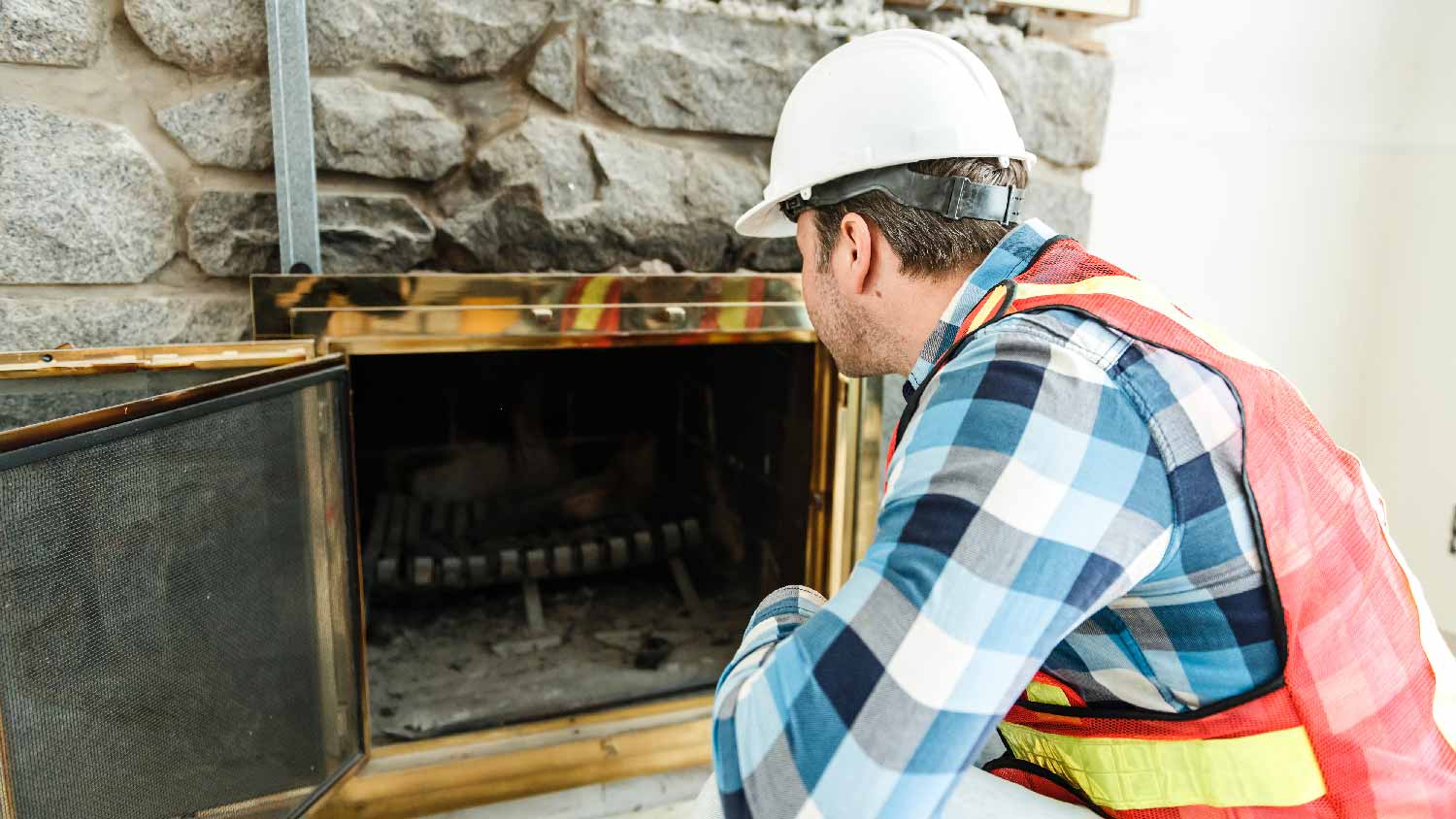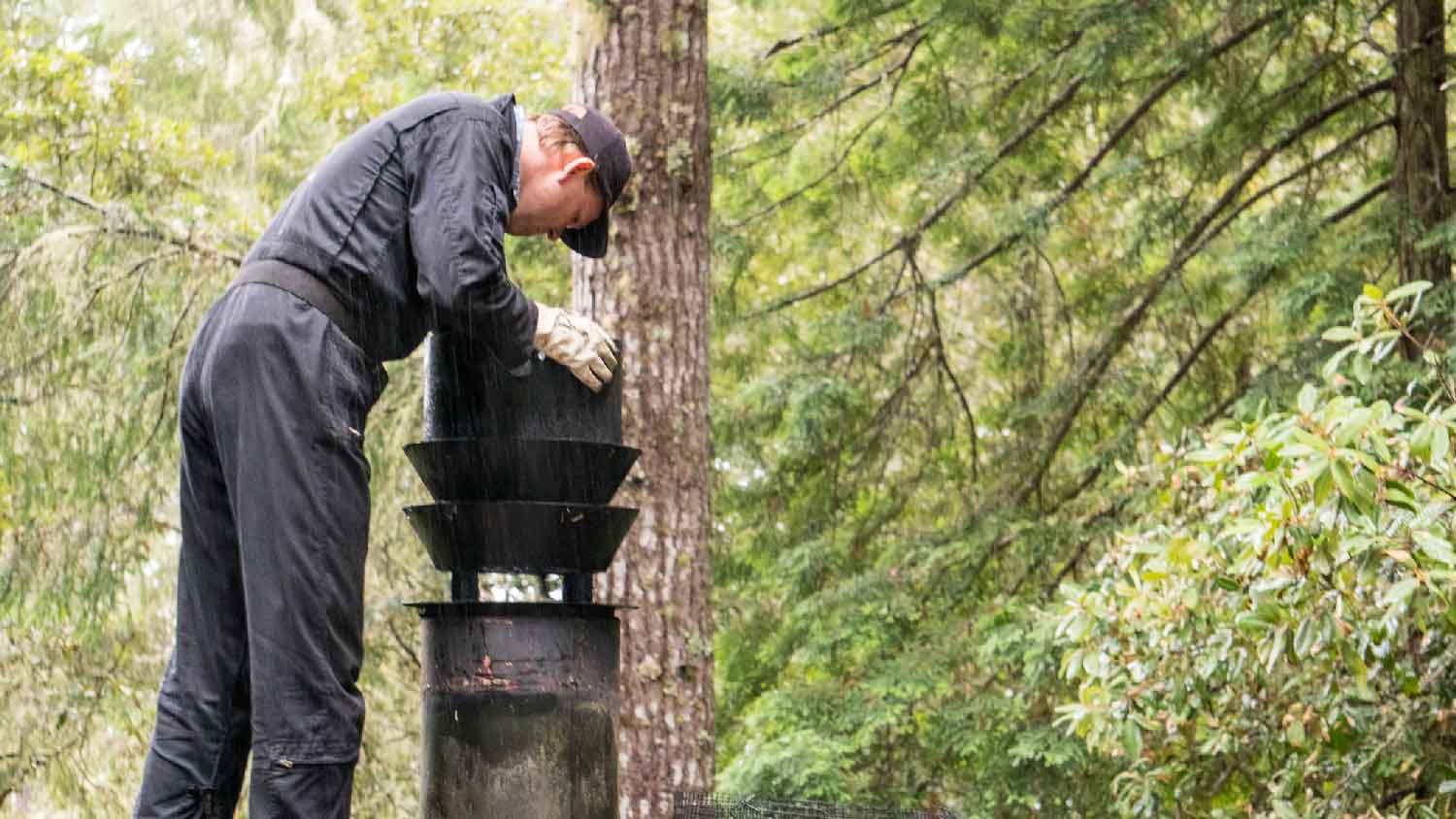
Sealing your chimney is one of the most affordable ways to prevent water from penetrating the bricks. This guide breaks down the cost to seal a chimney.
It’s not hard to tell if your flue is open—but unless you can breathe smoke, it sure is important


If you try to run your fireplace with a closed flue, you’re going to have a rough time—namely, smoke will fill your living room, leaving behind a coughing crowd and a campfire scent that may not come out of your upholstery for weeks. On the other hand, if you leave your flue open all the time, you might see higher gas and energy bills since your HVAC system will be working hard to heat or cool the neighborhood. So how can you tell if the flue is open?
If you don’t know, this is a pretty easy problem to fix! Here’s what you need to know to get your next cozy fireside night on in peace.
A fireplace flue is also known as a chimney damper and is the gadget that seals your chimney shut to the outside air when you aren’t using your fireplace. This prevents air-conditioned or heated air from escaping your home when the fireplace is not in use.
Of course, the flue is also used to vent smoke when you are using your fireplace, which is why it can be opened in the first place. Anyone who’s ever tried to start a fire with a closed flue knows exactly how important this piece of equipment is.
So if you’re preparing to start a fire, you need to ensure your flue is open—and if you’re done with your fireplace for the season (or even just the evening), closing the flue will help keep your home as efficient as possible and drive your energy bills down.
So, how can you tell which position it’s in? There are a few different options.

Without further ado, let’s find out if your flue is open or closed.
The first step is the simplest: Just take a look! Literally put your head into your fireplace (while it’s not in use, of course!) and take a look skyward. Depending on the type of flue you have, you may actually see daylight coming in from the top of the chimney, or an open metal tube that you can see daylight through. If the tube is closed or you can’t see daylight, your flue is likely closed—or in need of serious unclogging. (Note: You may need to use a flashlight for this step.)
Another way to tell if your flue is open or closed is to feel with your hand inside your fireplace for a draft, especially if it’s chilly outside. Since an open chimney damper will allow outside air in as well as inside air out, feeling a draft in your otherwise heated home is a surefire way to tell if your flue is open.
Although the specific controls you have will vary depending on what kind of chimney damper setup you have, you can play around with them to get a sense for whether the flue might be open or closed. For example, some types of fireplace flues utilize a cable that you have to pull to open the flue, while others use a rod, a knob, or another method. Combine this step with either the visual check or feeling for a draft to learn which setting is which with your flue, and then, in the future, you’ll be able to tell which position it’s in simply by checking the controls.
If you’re still not sure whether or not your fireplace flue is open, we do not recommend starting a fire to find out. Even a small fire can lead to serious health hazards when smoke backs up and fills your home. It’s better to hire a professional to help you than to put your lungs on the line.

Keeping your flue in proper, working order is one important part of maintaining a healthy fireplace—but it’s not the only one! Here are a few more tips to keep in mind:
Keep it clean: While ash and soot will almost assuredly accumulate in your fireplace over time, keeping the area clean will help keep the space in proper, working order for longer—and, more importantly, keep harmful tar vapors from condensing on the walls, which can cause decreased air quality or even a chimney fire. That’s why it’s important to have your chimney professionally cleaned at least once a year, along with giving it a good sweep after each fire.
Use a chimney liner: A flexible tube that connects to your stove pipe or which lines your fireplace chimney and helps drive smoke up and out of your home, a chimney liner, also known as a flue liner, can increase the efficiency of your fireplace and keep it cleaner for longer. A new chimney liner costs about $2,500 to install, but when cared for correctly and regularly cleaned, it should last between 15 and 25 years.
Still not sure if your flue is open or closed—or need help with another fireplace-related task? Your local chimney inspector can help!
I had Ace Fireplace Services install custom chimney caps for my home, and the results are stunning. They fit like a glove and have added a touch of sophistication to my chimney. I can't recommend their services enough.
Custom Paint Jobs LLC turned our outdated bathroom into a modern masterpiece.
We used Unique Hardwood Floor LLC three years ago to work on the floors of a 70 year old home that needed a great deal of work. Some floors needed repairs, some were replaced and others just needed to be refinished. It was a complicated job as they needed to blend the old and the new to...
Had a ceiling collapse in my rental unit. Scott responded quickly to repair the ceiling in a timely manner.
I had what looked like a failed hard drive on my laptop. Unable to boot, tried all the repair disks and could not get the laptop to start up. The laptop had been acting quirky and even had the blue screen of death before it failed to start up. Eric gave me the straight story on odds of...
My brother got information on this company while at the Garden Show at Cincinnati's Duke Energy Center a few weeks ago. A representative he spoke to suggested taking pictures of the chair he wanted re-upholstered and sending it to them via email for an estimate. He took pictures of the...
From average costs to expert advice, get all the answers you need to get your job done.

Sealing your chimney is one of the most affordable ways to prevent water from penetrating the bricks. This guide breaks down the cost to seal a chimney.

If you’re experiencing chimney airflow problems, a new damper may be in order. Use this guide to learn what goes into your chimney damper replacement cost.

Chimney repair costs can vary by the type of chimney you have and the required repairs. Use this guide to help you estimate project costs.

Here is your guide for how to empty a fireplace ash dump so you can keep your hearth tidy, safe, and running efficiently.

Not sure who to call for chimney repairs or debating doing it yourself? Take a look at the benefits and potential hazards of this project.

When considering a new gas fireplace, a common question is: Does a gas fireplace need a chimney? We share the answer and much more.